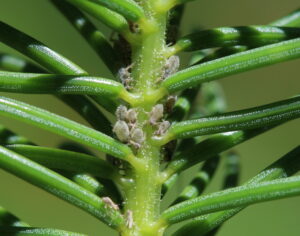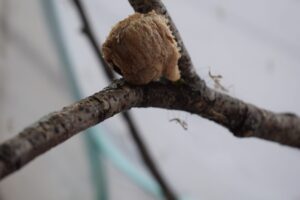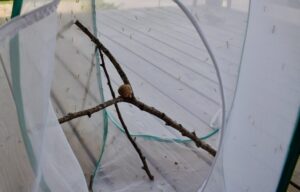You might think that cold weather brings an end to your battle with bugs, but insects can pop up unexpectedly indoors during the winter months too. Every year, a few people contact us concerned about some bugs that came into their home on their firewood, Christmas tree, or other holiday decorations. This is very rare but can be unnerving. Don’t worry. The vast majority of these insects are harmless and there are a few simple steps you can take to keep them from bothering you.
It’s important to understand why these bugs end up in your home. Insects can hitch a ride into your home on plant material like house plants, firewood, and Christmas trees. Many insects shelter in firewood or evergreen trees over winter to protect them from the elements. When they get into the warmth of your home they may get confused and think that it’s spring. The insects then hatch or emerge from dormancy and look for something to eat. Unfortunately for them, your home lacks both the right food and the right climate for them to survive. They usually quickly die. This means that, in the vast majority of cases, if you either kill or catch and release the insects that you find and wait a week, your insect problem should clear up. Here are a few of the types of insects you might encounter:
Firewood
Firewood is often cut from dead or dying trees. Many of these trees are infested with insects even before you start chopping them. This is one of the reasons why we caution not to move firewood long distances. You never know what you might be bringing along for the ride. Common insects that can emerge from firewood indoors include woodboring beetles, native bees, and ants. These insects feed on or nest in dead wood. Although it is highly unlikely that they will attack the wood in your house, they can still be a troublesome surprise. If they show up you can either capture them and put them outside or kill them by vacuuming them up. You can also try to reduce the number of hitchhikers by changing when you chop your wood and how you store it. Learn more here.
Holiday decorations
The needles and bows of evergreen trees offer excellent shelter from the harsh elements for animals of all sizes. Unfortunately, insects occasionally pick a tree destined for someone’s living room. These insects are highly unlikely to cause any harm to you or your home and are easily dealt with.
The two most common stowaways are aphids and praying mantises. Aphids are small with round abdomens and long legs (image 1) and have both a winged and wingless form. They may be seen on the branches of your decorations or on nearby furniture. Praying mantises usually travel indoors as an egg mass (image 2). Each egg mass can contain hundreds of baby mantises (image 3). When they hatch they quickly disperse (probably to avoid being eaten by a sibling). Both types of insect generally don’t survive more than a week in your home since they will not find the food they need. They can be easily disposed of by vacuuming them up. Or, if you have an enthusiastic entomologist in the house, the mantises can be captured and kept as pets.
- IMAGE 1: Aphids sometimes feed on greenery that is harvested for holiday decorations. When the plants are brought indoors, the aphids may emerge. Image by S. Rae on flickr
- IMAGE 2: Praying mantis egg cases are loosely oval shaped, pale brown, and made of a Styrofoam-like material. They are often attached to small branches. Image by Elizabeth Barnes, Purdue University
- IMAGE 3: When a praying mantis egg case hatches around a hundred baby mantises emerge and quickly spread into the surrounding area.
There is a new and invasive insect that has started showing up occasionally in holiday plants: the spotted lanternfly. Although these insects are unlikely to be able to establish in the winter, it is vital that you report them if you encounter them. We need to understand how they are spreading if we are to keep them contained. You can print out and make your own spotted lanternfly to keep around as a reminder of what to look for.
A good way to avoid having these insects end up in your home is to inspect your decorations before you bring them into the house. Remove any insects that you find. If you come across mantis eggs, you can clip off the branch and tie it to a sheltered part of a tree near your garden. You’ll have a few more predators to keep down the pest insects come spring! If you find a spotted lanternfly or their egg masses, please put them in a plastic bag, save them, and send in a report.
Finally, a caution. Don’t spray your Christmas tree or any of your decorations with an insecticide*. Not only is it unnecessary post-harvest but some pesticides are flammable and carry other risks if used improperly. There are much simpler, more effective, and less risky ways to prevent or deal with insect hitchhikers in your home.
Bottom line: it’s very rare to bring any insects into your home with your decorations and firewood. The ones that do hitch a ride are almost always harmless to you and your home. A quick cleanup and a little patience should take care of them. If that doesn’t work, you can always contact your local extension agent for help!
Images by Elizabeth Barnes, Purdue University and S. Rae on flickr
*If you are a Christmas tree grower, you can find a thorough discussion of Christmas tree IPM here or by contacting your local extension agent.


